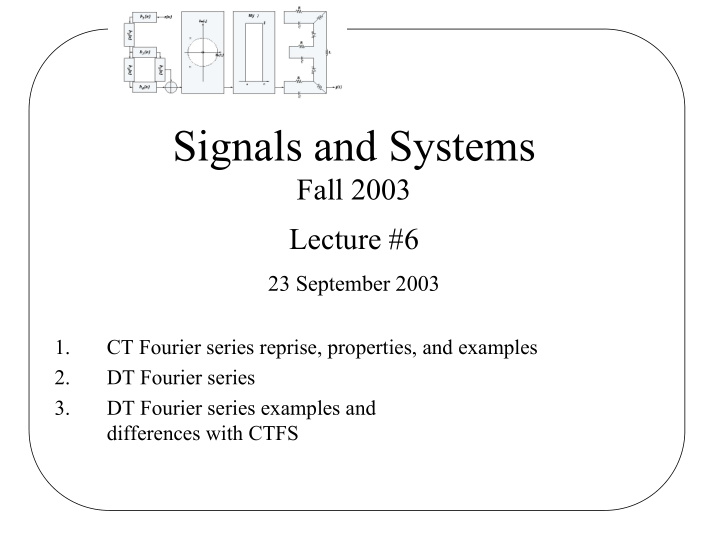



Signals and Systems Fall 2003 Lecture #6 23 September 2003 1. CT Fourier series reprise, properties, and examples 2. DT Fourier series 3. DT Fourier series examples and differences with CTFS
CT Fourier Series Pairs Skip it in future for shorthand
Another (important!) example: Periodic Impulse Train — All components have: (1) the same amplitude, & (2) the same phase.
(A few of the) Properties of CT Fourier Series • Linearity • Conjugate Symmetry • Time shift Introduces a linear phase shift ∝ t o
Example: Shift by half period
• Parseval’s Relation Energy is the same whether measured in the time-domain or the frequency-domain • Multiplication Property
Periodic Convolution x ( t ), y ( t ) periodic with period T
Periodic Convolution (continued) Periodic convolution: Integrate over any one period (e.g. - T /2 to T /2)
Periodic Convolution (continued) Facts 1) z ( t ) is periodic with period T (why?) 2) Doesn’t matter what period over which we choose to integrate: Periodic convolution 3) in time Multiplication in frequency!
Fourier Series Representation of DT Periodic Signals • x [ n ] - periodic with fundamental period N , fundamental frequency Only e j ω n which are periodic with period N will appear in the FS • • There are only N distinct signals of this form • So we could just use • However, it is often useful to allow the choice of N consecutive values of k to be arbitrary . ⇓
DT Fourier Series Representation ∑ = Sum over any N consecutive values of k k =< N > — This is a finite series { a k } - Fourier (series) coefficients Questions: 1) What DT periodic signals have such a representation? 2) How do we find a k ?
Answer to Question #1: Any DT periodic signal has a Fourier series representation
A More Direct Way to Solve for a k Finite geometric series
So, from
DT Fourier Series Pair Note: It is convenient to think of a k as being defined for all integers k . So: 1) a k+N = a k — Special property of DT Fourier Coefficients. 2) We only use N consecutive values of a k in the synthesis equation. (Since x [ n ] is periodic, it is specified by N numbers, either in the time or frequency domain)
Example #1: Sum of a pair of sinusoids 0 a -1+16 = a -1 = 1/2 1/2 1/2 a 2+ 4×16 = a 2 = e j π /4 /2 e j π /4 /2 e -j π /4 /2 0 0
Example #2: DT Square Wave Using n = m - N 1
Example #2: DT Square wave (continued)
Convergence Issues for DT Fourier Series: Not an issue, since all series are finite sums. Properties of DT Fourier Series: Lots, just as with CT Fourier Series Example:
Recommend
More recommend